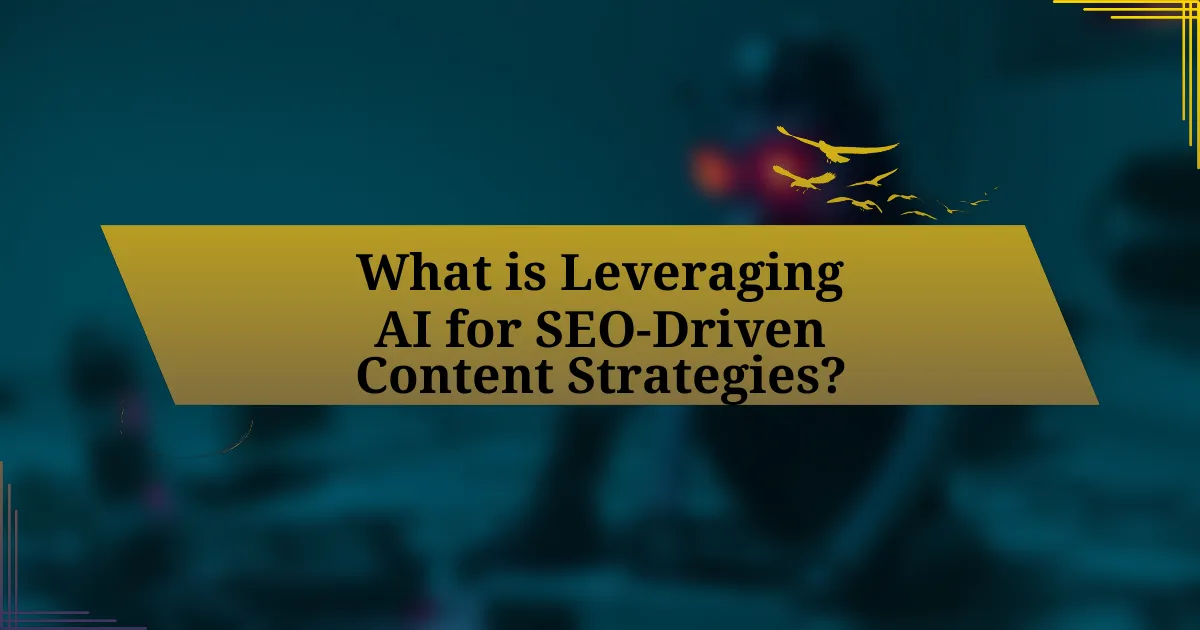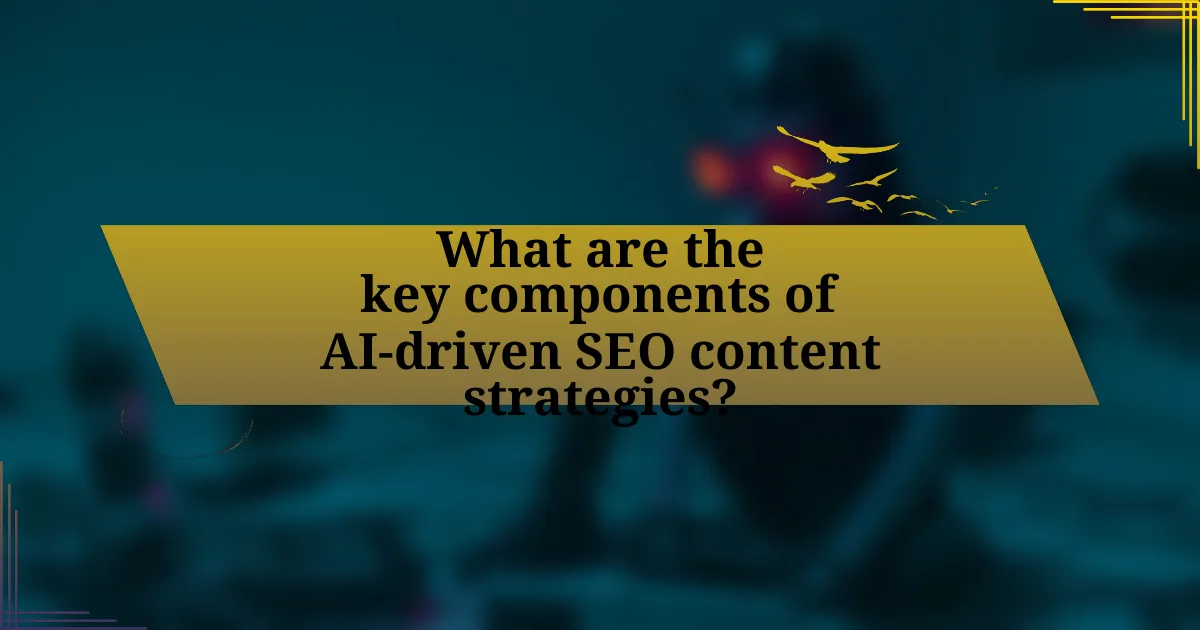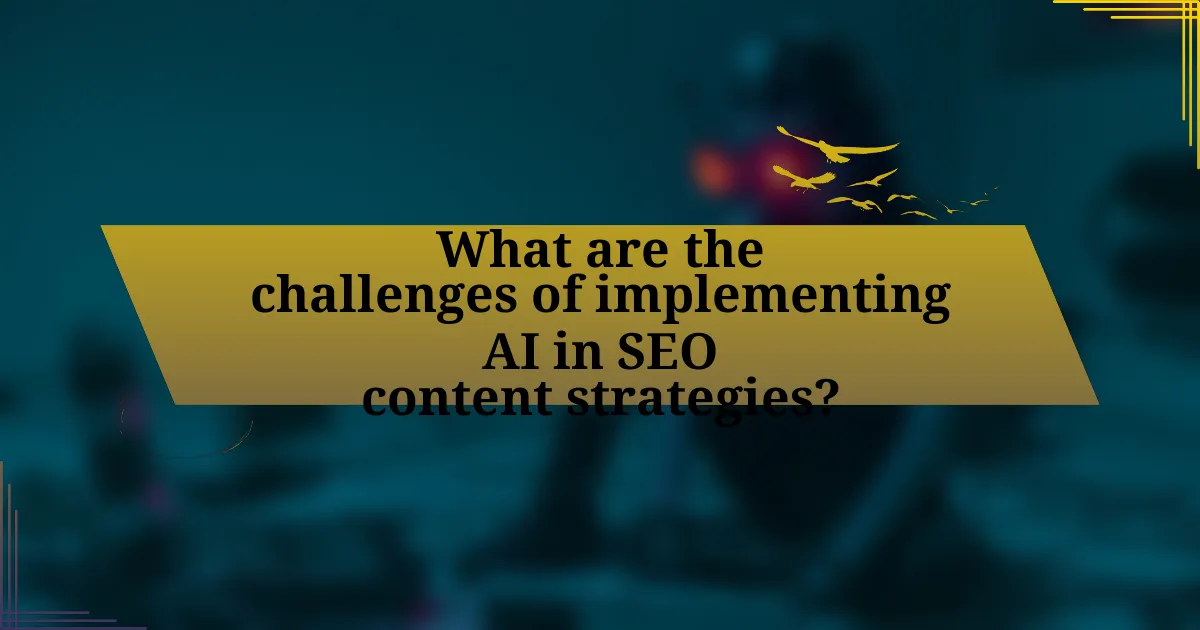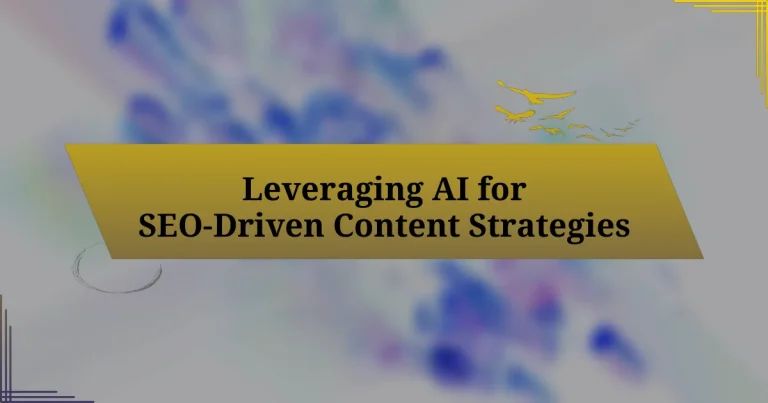Leveraging AI for SEO-driven content strategies involves the use of artificial intelligence technologies to enhance content creation, optimization, and distribution for improved search engine rankings. The article explores how AI enhances keyword research, content relevance, and user experience through advanced algorithms and data analysis. It discusses specific AI technologies such as natural language processing and machine learning, and their role in predicting keyword trends and optimizing content. Additionally, the article addresses the challenges of implementing AI in SEO strategies, the importance of balancing AI with human creativity, and best practices for measuring the success of AI-driven content initiatives.

What is Leveraging AI for SEO-Driven Content Strategies?
Leveraging AI for SEO-driven content strategies involves utilizing artificial intelligence technologies to enhance the creation, optimization, and distribution of content that ranks well in search engines. AI tools analyze vast amounts of data to identify trending keywords, user intent, and content gaps, enabling marketers to produce targeted content that meets audience needs. For instance, a study by HubSpot found that companies using AI for content optimization saw a 30% increase in organic traffic. This demonstrates that integrating AI into SEO strategies can significantly improve visibility and engagement.
How does AI enhance SEO-driven content strategies?
AI enhances SEO-driven content strategies by optimizing keyword research, improving content relevance, and personalizing user experiences. Through advanced algorithms, AI analyzes vast amounts of data to identify trending keywords and topics, enabling content creators to target specific audience interests effectively. For instance, tools like Google’s BERT utilize natural language processing to understand context, which helps in crafting content that aligns with user search intent. Additionally, AI-driven analytics provide insights into user behavior, allowing for continuous content optimization based on performance metrics. This data-driven approach leads to higher search engine rankings and increased organic traffic.
What specific AI technologies are used in SEO content creation?
Specific AI technologies used in SEO content creation include natural language processing (NLP), machine learning algorithms, and content optimization tools. NLP enables the analysis of search intent and keyword relevance, allowing for the creation of content that aligns with user queries. Machine learning algorithms help in predicting trends and user behavior, which informs content strategy. Content optimization tools, such as Clearscope and Surfer SEO, utilize AI to analyze top-performing content and provide recommendations for improving SEO performance. These technologies collectively enhance the effectiveness and relevance of SEO-driven content strategies.
How does AI analyze user intent for better content targeting?
AI analyzes user intent for better content targeting by utilizing natural language processing (NLP) and machine learning algorithms to interpret user queries and behaviors. These technologies enable AI to assess the context, sentiment, and specific keywords within user interactions, allowing it to categorize intent into various types such as informational, navigational, or transactional. For instance, a study by Google indicated that 70% of search queries are now longer and more conversational, highlighting the need for AI to understand nuanced language patterns. By analyzing vast amounts of data from user interactions, AI can identify trends and preferences, tailoring content to meet the specific needs of users, thereby enhancing engagement and conversion rates.
Why is leveraging AI important for content strategies?
Leveraging AI is important for content strategies because it enhances efficiency and personalization in content creation and distribution. AI tools can analyze vast amounts of data to identify trends, optimize content for search engines, and tailor messaging to specific audience segments. For instance, a study by McKinsey found that companies using AI in their marketing strategies can increase their productivity by 20-30%. This demonstrates that AI not only streamlines processes but also significantly improves engagement and conversion rates, making it a crucial component of effective content strategies.
What advantages does AI provide over traditional SEO methods?
AI provides several advantages over traditional SEO methods, primarily through enhanced data analysis and automation capabilities. AI algorithms can process vast amounts of data quickly, identifying patterns and trends that human analysts might miss, leading to more informed decision-making. For instance, AI tools can analyze user behavior in real-time, allowing for dynamic content optimization that adapts to changing user preferences. Additionally, AI can automate repetitive tasks such as keyword research and content generation, significantly reducing the time and effort required for SEO campaigns. This efficiency not only improves productivity but also allows marketers to focus on strategic initiatives. Furthermore, AI-driven insights can lead to more personalized user experiences, which are increasingly favored by search engines, ultimately improving search rankings.
How does AI improve content personalization and relevance?
AI improves content personalization and relevance by analyzing user data to tailor content to individual preferences and behaviors. Through machine learning algorithms, AI can process vast amounts of data, identifying patterns in user interactions, such as browsing history and engagement metrics. This enables the creation of customized content recommendations that align with users’ interests, thereby increasing engagement and satisfaction. For instance, platforms like Netflix and Amazon utilize AI-driven recommendation systems that enhance user experience by suggesting content based on previous viewing or purchasing habits, leading to higher retention rates and increased sales.

What are the key components of AI-driven SEO content strategies?
The key components of AI-driven SEO content strategies include keyword optimization, content personalization, predictive analytics, and automated content generation. Keyword optimization utilizes AI algorithms to identify high-value keywords and phrases that enhance search visibility. Content personalization leverages user data to tailor content to individual preferences, improving engagement and conversion rates. Predictive analytics analyzes user behavior and trends to forecast content performance, allowing for data-driven decision-making. Automated content generation employs natural language processing to create relevant and high-quality content efficiently, ensuring consistency and scalability in content production. These components collectively enhance the effectiveness of SEO strategies by aligning content with user intent and search engine algorithms.
How do keyword research tools powered by AI function?
Keyword research tools powered by AI function by utilizing algorithms and machine learning to analyze vast amounts of data, identifying relevant keywords based on search volume, competition, and user intent. These tools aggregate data from various sources, including search engines, social media, and competitor websites, to generate insights on keyword trends and opportunities. For instance, AI can predict keyword performance by examining historical data and user behavior patterns, allowing marketers to optimize their content strategies effectively. This data-driven approach enhances the accuracy of keyword suggestions, making it easier for users to target the right audience and improve their SEO outcomes.
What algorithms do these tools use to identify trending keywords?
Tools that identify trending keywords typically use algorithms such as natural language processing (NLP), machine learning, and data mining techniques. These algorithms analyze large datasets from various sources, including search engine queries, social media trends, and user-generated content, to detect patterns and shifts in keyword popularity. For instance, NLP algorithms can process and understand the context of words and phrases, while machine learning models can predict future trends based on historical data. Data mining techniques further enhance this process by extracting valuable insights from unstructured data, allowing for real-time identification of emerging keywords.
How can AI predict future keyword trends?
AI can predict future keyword trends by analyzing large datasets of search queries, user behavior, and content performance. Machine learning algorithms identify patterns and correlations within this data, allowing AI to forecast which keywords are likely to gain traction based on historical trends and emerging topics. For instance, tools like Google Trends and SEMrush utilize AI to track keyword popularity over time, providing insights into seasonal fluctuations and rising interests. This predictive capability is supported by the ability of AI to process vast amounts of data quickly, enabling marketers to make informed decisions about content strategies that align with anticipated search behaviors.
What role does content optimization play in AI-driven strategies?
Content optimization is crucial in AI-driven strategies as it enhances the relevance and visibility of digital content in search engines. By utilizing AI algorithms, businesses can analyze user behavior, keyword trends, and content performance to tailor their content effectively. For instance, a study by HubSpot found that optimized content can lead to a 14.6% increase in conversion rates compared to non-optimized content. This demonstrates that content optimization not only improves search engine rankings but also drives higher engagement and conversion, validating its essential role in AI-driven strategies.
How does AI assist in optimizing content for search engines?
AI assists in optimizing content for search engines by analyzing data patterns and user behavior to enhance keyword targeting and content relevance. Through natural language processing, AI tools can identify trending topics, suggest relevant keywords, and analyze competitors’ content strategies. For instance, tools like Google’s BERT algorithm utilize AI to understand the context of search queries, allowing content creators to align their writing with user intent. Additionally, AI-driven analytics can track performance metrics, enabling continuous improvement of content strategies based on real-time data.
What metrics does AI analyze to improve content performance?
AI analyzes several key metrics to improve content performance, including engagement rates, click-through rates (CTR), bounce rates, and conversion rates. Engagement rates measure how users interact with content, indicating its relevance and appeal. Click-through rates assess the effectiveness of headlines and calls to action, while bounce rates reveal how well content retains visitors. Conversion rates track the percentage of users who complete desired actions, providing insight into content effectiveness in driving business goals. These metrics collectively inform AI algorithms, enabling continuous optimization of content strategies for better performance.

What are the challenges of implementing AI in SEO content strategies?
The challenges of implementing AI in SEO content strategies include data quality, algorithm bias, and integration complexity. Data quality is crucial because AI relies on accurate and relevant data to generate effective content; poor data can lead to suboptimal outcomes. Algorithm bias can occur when AI models are trained on biased datasets, resulting in content that may not resonate with diverse audiences or reflect accurate information. Integration complexity arises from the need to align AI tools with existing SEO practices and workflows, which can require significant time and resources. These challenges highlight the necessity for careful planning and ongoing evaluation when incorporating AI into SEO strategies.
What common pitfalls should marketers avoid when using AI?
Marketers should avoid over-reliance on AI-generated content, as it can lead to a lack of authenticity and engagement with the target audience. When marketers depend solely on AI for content creation, they risk producing generic material that fails to resonate with consumers, ultimately diminishing brand loyalty. Additionally, neglecting to incorporate human oversight can result in inaccuracies or misinterpretations of data, which can mislead marketing strategies. A study by the Content Marketing Institute found that 70% of marketers believe that human creativity is essential for effective content, highlighting the importance of balancing AI capabilities with human insight.
How can reliance on AI lead to content homogenization?
Reliance on AI can lead to content homogenization by standardizing the creation process, resulting in similar outputs across various platforms. AI algorithms often analyze existing content to generate new material, which can lead to repetitive themes, structures, and language. For instance, a study by the Content Marketing Institute found that 70% of marketers believe AI-generated content lacks originality, indicating a trend toward uniformity. This reliance on data-driven models can stifle creativity and diversity in content, as AI tends to favor popular or trending topics, further contributing to a lack of unique perspectives.
What ethical considerations arise from using AI in content creation?
The ethical considerations arising from using AI in content creation include issues of plagiarism, misinformation, and bias. Plagiarism occurs when AI-generated content closely resembles existing works without proper attribution, undermining intellectual property rights. Misinformation can arise if AI produces inaccurate or misleading content, potentially harming public understanding and trust. Additionally, bias in AI algorithms can lead to the perpetuation of stereotypes or exclusion of diverse perspectives, which can skew the representation of information. These ethical concerns highlight the need for transparency, accountability, and adherence to ethical standards in AI-driven content creation.
How can businesses effectively integrate AI into their SEO strategies?
Businesses can effectively integrate AI into their SEO strategies by utilizing AI-driven tools for keyword research, content optimization, and predictive analytics. These tools analyze vast amounts of data to identify trending keywords and topics, enabling businesses to create content that aligns with user intent. For instance, platforms like Clearscope and MarketMuse leverage AI to provide insights on content quality and relevance, which can enhance search engine rankings. Additionally, AI algorithms can predict changes in search trends, allowing businesses to adapt their strategies proactively. According to a study by HubSpot, companies that use AI in their marketing strategies see a 14% increase in productivity, demonstrating the tangible benefits of AI integration in SEO efforts.
What steps should be taken to align AI tools with business goals?
To align AI tools with business goals, organizations should first define clear objectives that reflect their strategic priorities. This involves identifying specific business outcomes, such as increasing revenue, improving customer engagement, or enhancing operational efficiency. Once objectives are established, the next step is to assess the capabilities of available AI tools to ensure they can effectively support these goals. For instance, tools that analyze customer data can help tailor marketing strategies to boost engagement.
Following this assessment, organizations should integrate AI tools into existing workflows, ensuring that teams are trained to utilize these technologies effectively. This integration should include setting measurable KPIs to evaluate the performance of AI tools against the defined business objectives. Regularly reviewing these metrics allows for adjustments and optimizations, ensuring that the AI tools remain aligned with evolving business goals.
Research indicates that companies that align AI initiatives with strategic objectives see a 20% increase in productivity and a 15% improvement in customer satisfaction (McKinsey & Company, 2021). This evidence underscores the importance of a structured approach to aligning AI tools with business goals.
How can teams ensure collaboration between AI and human creativity?
Teams can ensure collaboration between AI and human creativity by integrating AI tools that enhance creative processes while allowing human input to guide the direction of content. For instance, using AI for data analysis can provide insights into trending topics, which human creators can then interpret and expand upon with unique perspectives. Research shows that organizations that combine AI capabilities with human creativity can achieve up to 30% higher productivity in content creation, as AI handles repetitive tasks, freeing humans to focus on innovative ideas. This synergy fosters an environment where both AI and human contributions are valued, leading to more effective SEO-driven content strategies.
What best practices should be followed for leveraging AI in SEO-driven content strategies?
To effectively leverage AI in SEO-driven content strategies, it is essential to utilize data-driven insights for content creation and optimization. AI tools can analyze search trends, user behavior, and keyword performance, enabling marketers to tailor content that meets audience needs. For instance, using AI-powered platforms like Clearscope or MarketMuse can enhance keyword targeting and content relevance, leading to improved search rankings. Additionally, implementing natural language processing (NLP) techniques helps in understanding user intent, allowing for the creation of more engaging and contextually relevant content. Research indicates that websites utilizing AI for content optimization can see a significant increase in organic traffic, with some studies showing up to a 30% improvement in search visibility.
How can businesses measure the success of AI-driven content strategies?
Businesses can measure the success of AI-driven content strategies by analyzing key performance indicators (KPIs) such as engagement rates, conversion rates, and organic traffic growth. Engagement rates can be assessed through metrics like time spent on page, bounce rates, and social shares, which indicate how well the content resonates with the audience. Conversion rates, which reflect the percentage of visitors completing desired actions, provide insight into the effectiveness of the content in driving business goals. Additionally, tracking organic traffic growth through tools like Google Analytics can reveal the impact of AI-generated content on search engine visibility and overall reach. These metrics collectively validate the effectiveness of AI-driven content strategies in achieving business objectives.
What tools and resources are recommended for effective implementation?
For effective implementation of AI-driven SEO content strategies, tools such as SEMrush, Ahrefs, and Google Analytics are recommended. SEMrush provides comprehensive keyword research and competitive analysis, enabling users to optimize content effectively. Ahrefs offers robust backlink analysis and site auditing features, which are crucial for improving search engine rankings. Google Analytics allows for tracking user behavior and content performance, providing insights that inform content strategy adjustments. These tools collectively enhance the ability to create data-driven, SEO-optimized content, leading to improved visibility and engagement.

